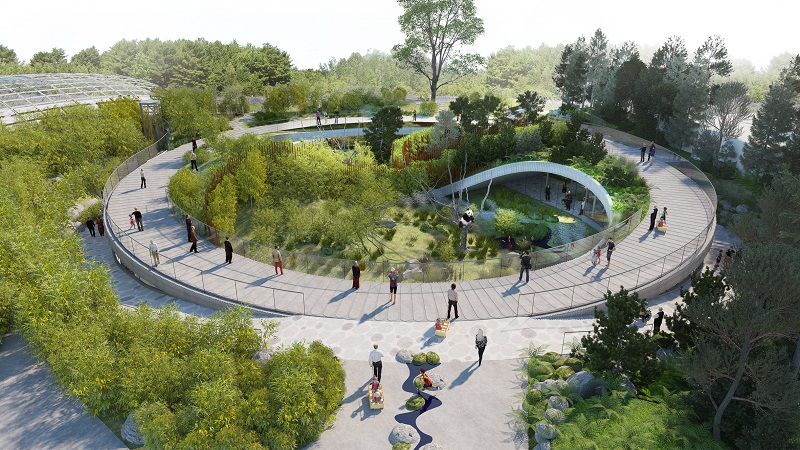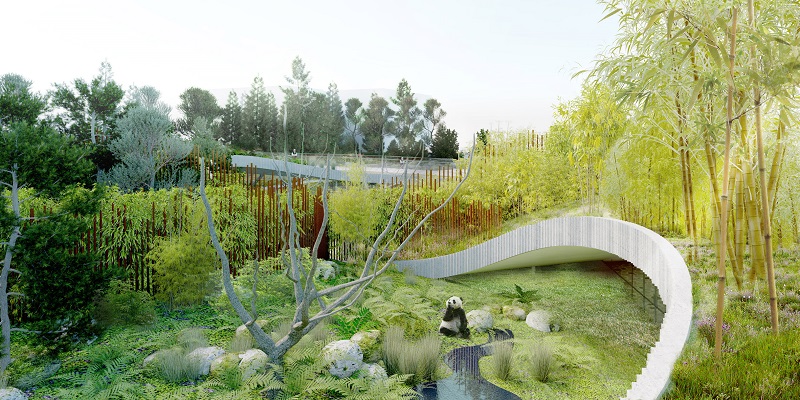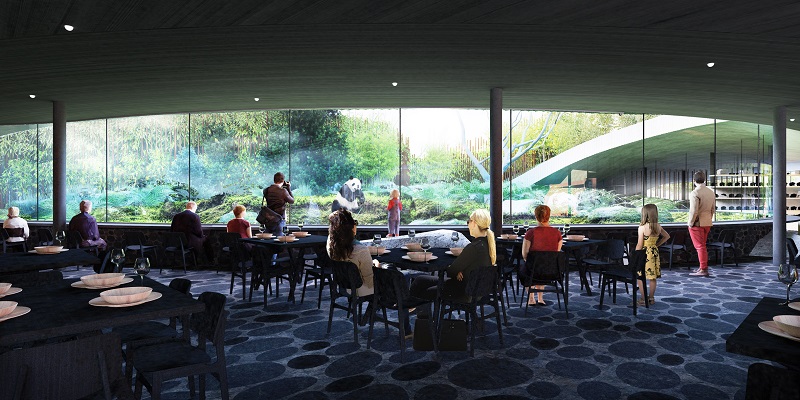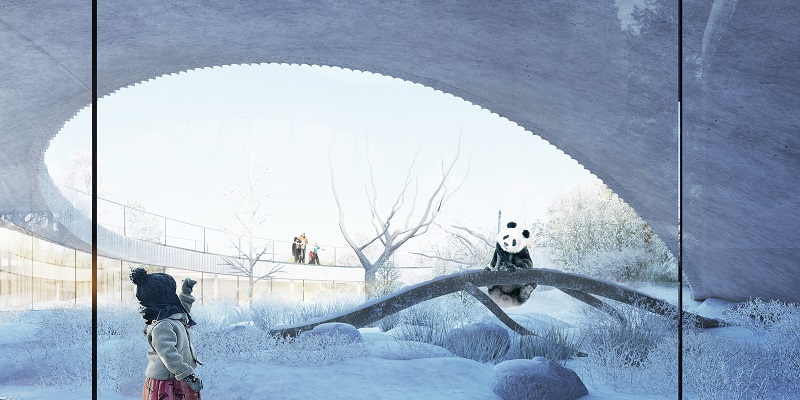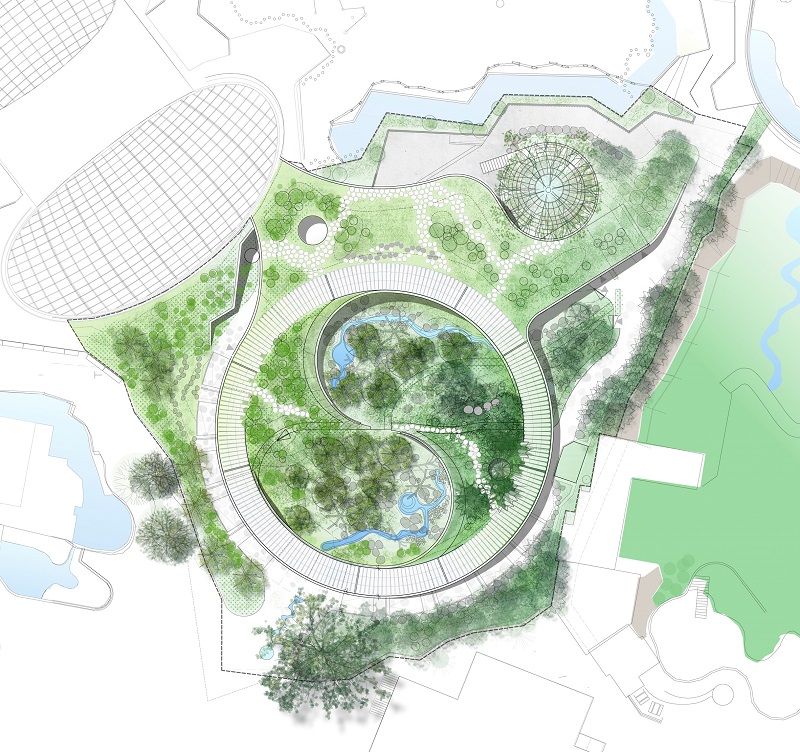Panda House, Copenhagen Zoo
In March 2017, designs were released for a new yin-and-yang-shaped Panda House for Copenhagen Zoo, Denmark.
The project is a collaboration between Bjarke Ingels Group (BIG), Schønherr Landscape Architects and MOE. The Panda House is intended to resemble the animals’ natural habitat, creating a peaceful environment for one of the world’s rarest mammals. Copenhagen Zoo, one of the oldest in Europe, already includes the award-winning Elephant House, designed by Norman Foster.
The Panda House encompasses a 1,250 sq. m indoor site and a 1,200 sq. m outdoor area, with the circular shape formed by the surrounding existing facilities at the intersection of a number of walkways. The design gives the impression that humans are the ‘visitors in the panda’s home, rather than pandas being the exotic guests from faraway lands’, with the eye-level view heightening a sense of immersion within wildlife and nature.
The ground floor provides access to the interior spaces via a ramp, while the upper floor leads to a rocky slope through Nordic plants and a dense bamboo forest. The vegetation and landscaping mimics the natural environment of the pandas, with provision for both shade and sun, by creating a dense and lush ‘mist forest’ and a light green bamboo forest.
The ground is raised at both ends of the yin-and-yang symbol, allowing direct views into the habitat. Visitors can dine in a restaurant on the ground floor, allowing them to observe the pandas and the adjacent elephants.
Construction on the habitat is scheduled to begin later in 2017, once the budget of 150 million DKK has been secured. It is due to open in 2018, when two giant pandas from Chengdu will arrive at the zoo. The pandas are being given by the Chinese government as a goodwill gesture following the Queen of Denmark’s visit in 2014.
Bjarke Ingels, Founding Partner, BIG said:
“To design a home for someone is like capturing their essence, their character and personality in built form. In the case of the two great pandas, their unique solitary nature requires two similar but separate habitats - one for her and one for him. The habitat is formed like a giant yin and yang symbol, two halves: the male and the female, complete each other to form a single circular whole.
"The curvy lines are undulating in section to create the necessary separation between him and her - as well as between them and us. Located at the heart of the park, we have made the entire enclosure accessible from 360-degrees, turning the two pandas into the new rotation point for Copenhagen Zoo.”
Steffen Stræde, Zoo Director, Copenhagen Zoo said:
“Copenhagen Zoo’s idea-driven organisation was key in defining the team we wanted to work with on the new Panda House project. It’s part of our DNA to let everyone from zookeepers, to gardeners and vets, influence the design and function of the facilities to secure the well-being of our animals. The team understood our approach and successfully integrated it into their design process to create a world-class home for these adored pandas.”
Images and content courtesy of BIG.
[edit] Related articles on Designing Buildings Wiki
Featured articles and news
British Architectural Sculpture 1851-1951
A rich heritage of decorative and figurative sculpture. Book review.
A programme to tackle the lack of diversity.
Independent Building Control review panel
Five members of the newly established, Grenfell Tower Inquiry recommended, panel appointed.
ECA progress on Welsh Recharging Electrical Skills Charter
Working hard to make progress on the ‘asks’ of the Recharging Electrical Skills Charter at the Senedd in Wales.
A brief history from 1890s to 2020s.
CIOB and CORBON combine forces
To elevate professional standards in Nigeria’s construction industry.
Amendment to the GB Energy Bill welcomed by ECA
Move prevents nationally-owned energy company from investing in solar panels produced by modern slavery.
Gregor Harvie argues that AI is state-sanctioned theft of IP.
Heat pumps, vehicle chargers and heating appliances must be sold with smart functionality.
Experimental AI housing target help for councils
Experimental AI could help councils meet housing targets by digitising records.
New-style degrees set for reformed ARB accreditation
Following the ARB Tomorrow's Architects competency outcomes for Architects.
BSRIA Occupant Wellbeing survey BOW
Occupant satisfaction and wellbeing tool inc. physical environment, indoor facilities, functionality and accessibility.
Preserving, waterproofing and decorating buildings.







